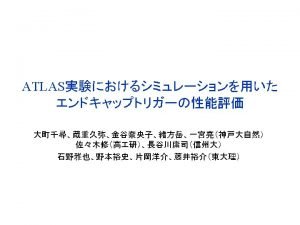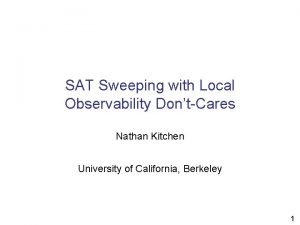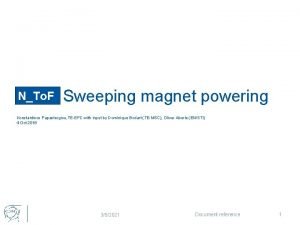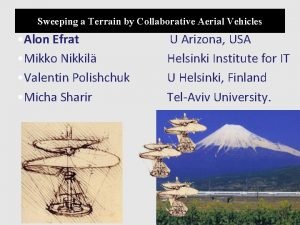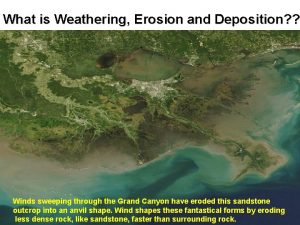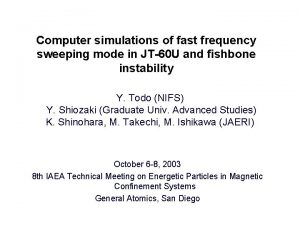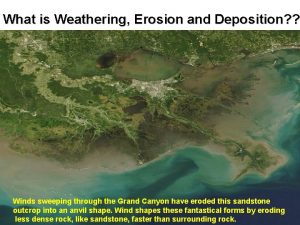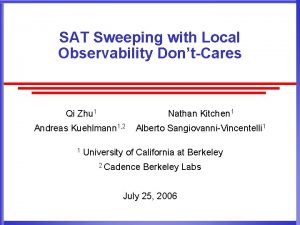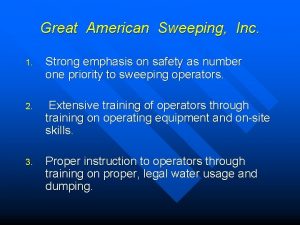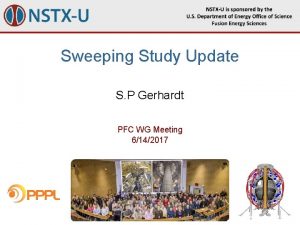EN Muon sweeping in the M 2 muon
























- Slides: 24

EN Muon sweeping in the M 2 muon beam line for the COMPASS experiment with a view to its potential for CLIC Lau Gatignon / EN-MEF T 6 COMPASS

Courtesy: H. Burkhardt A potential problem for CLIC: Muons from beam halo Beam tails are scraped away by a collimation system in the BDS. Below we show simulated profiles of the beam at the BDS entrance (core of beam in red) From I. Agapov et al, 2009, to be published From these simulations one estimates that a fraction 2 10 -4 hit the collimators, i. e. about 2. 4 108 particles per train assuming a total flux of 1. 24 1012 per train. Preliminary estimates indicate that out of those ~ 2 105 would reach the detectors. The final rates remain to be studied with BDSIM using the final and detailed geometry LG, MDI meeting 19 -02 -2010 Muon sweeping in M 2 beam line 2

H. Burkhardt, CLIC 09 ‘Typical’ muons at CIC have momenta of a few hundred Ge. V/c LG, MDI meeting 19 -02 -2010 Muon sweeping in M 2 beam line 3

LG, MDI meeting 19 -02 -2010 Muon sweeping in M 2 beam line Deepa Angal-Kalinin Dipoles? ? ? 4


LG, MDI meeting 19 -02 -2010 Muon sweeping in M 2 beam line 6

LG, MDI meeting 19 -02 -2010 Muon sweeping in M 2 beam line 7

Basic approach to reduce muon halo: Toroidal fields in Iron Magnetised Iron has three main effects on muons: q Energy loss: d. E/dx ~ 1. 5 Ge. V/m q Multiple Coulomb scattering: q Magnetic deflection: For a useful effect, require qdefl >> qscatt , i. e. 450 L >> 106 √L or L >> 0. 05 m e. g. for qdefl > 10 qscatt one requires L ≥ 5 m In the M 2 beam we use two types of toroids: 1. SCRAPERS: 2. MIBS: LG, MDI meeting 19 -02 -2010 adjustable gap, no vacuum (? ), smaller outer coverage, expensive fixed gap, large coverage, cheap, vacuum tube can go through Muon sweeping in M 2 beam line 8

SCRAPERS (Magnetic Collimators) B Magnetic force Have to get polarity right…. LG, MDI meeting 19 -02 -2010 Muon sweeping in M 2 beam line 9

LG, MDI meeting 19 -02 -2010 Muon sweeping in M 2 beam line 10

4 Motors: 2 upstream, 2 downstream allows to follow beam divergence Have to stop current before moving jaws !!! LG, MDI meeting 19 -02 -2010 Muon sweeping in M 2 beam line 11

MIB = Magnetised Iron Block

Note: q Both SCRAPERS and MIBS are easy to power Typically operated with 100 to 200 Amps Resistance of one MIB coil (for L=1. 6 m) is ~ 100 m. Ohm Therefore 10 m of MIB consumes only ~150 A x 100 V ~ 15 k. W q There is not much reason to push the current This would lead to strong saturation of the field in the Iron and quick increase of the stray field on the main beam (but we use the quadrupolar stray field to measure the polarity) q There is (in principle) no effect of the field on the main beam whereas dipole fields would require compensation q The requirements on precision of machining are very modest See e. g. the picture of the MIB in he M 2 beam Just make sure there is good magnetic contact between blocks q The deflection of a 500 Ge. V/c muon by a 5 m long toroid is ~ 5 mrad After 2 km drift, it is deflected away by 10 m (well outside tunnel & detector) LG, MDI meeting 19 -02 -2010 Muon sweeping in M 2 beam line 13

The size of the Halo problem Flux (arbitrary units) Simulations based on the HALO program by C. Iselin (1974) ‘Good’ muons Halo after p absorber Halo after m momentum selection Note: Halo / ‘Good’ m ≈ 6 P (Ge. V/c) LG, MDI meeting 19 -02 -2010 Muon sweeping in M 2 beam line 14

The effect of muon sweeping in the M 2 muon beam for COMPASS With muon sweeping Y (mm) Without muon sweeping X (mm) LG, MDI meeting 19 -02 -2010 X (mm) Muon sweeping in M 2 beam line 15

Muon flux (arb. units) No sweeping Passive iron Magnetic collimation Y (mm) X (mm) LG, MDI meeting 19 -02 -2010 Muon sweeping in M 2 beam line 16

Outside 10 cm Muon flux (arb. units) Within 10 cm P (Ge. V/c) LG, MDI meeting 19 -02 -2010 P (Ge. V/c) Muon sweeping in M 2 beam line 17

Muons vs Halo Muons within 10 cm Muon flux (arb. units) Muons with r [10, 200] cm P (Ge. V/c) i. e. Halo (R=2 m) / Muons (R = 10 cm) ~ 5%, i. e. Halo/Muons in same surface ~ 1. 3 10 -4 LG, MDI meeting 19 -02 -2010 Gain > factor 100 Muon sweeping in M 2 beam line Excellent agreement With data! 18

Alternative possibility, based on MBPL dipole magnet, used in K 12 beam: q Fill gap with weak Iron q 40 mm diameter hole for beam passage q Run at 20 Amps (for 75 Ge. V/c main beam) q Put 3 magnets of 2 m length in series

LG, MDI meeting 19 -02 -2010 Muon sweeping in M 2 beam line 20

Correctors needed !

LG, MDI meeting 19 -02 -2010 Muon sweeping in M 2 beam line 22

Advantages: § Do not sweep muons upward, into the fields § In the limited length available (about 100 metres), in the presence of both positive and negative muons, avoid the problem of “refocussing” muons with the second toroid, which were swept away by the first one Disadvantages: § § Covers a smaller surface than e. g. a MIB Needs high-precision engineering and machining, hence more costly Stray field on beam axis needs to be compensated by two correction magnets It takes about 15 minutes for the field to stabilise after a current change. During that time the beam steering shifts continuously

Conclusions q The M 2 high-energy high-intensity muon beam provides a main beam of 4 108 muons of 160 Ge. V/c per SPS cycle to the COMPASS experiment. q These “good” muons are accompanied by a “halo”of about 3 109 muons from pion decays along the 600 metres long decay volume. q With a system of 7 magnetic collimators”(5 m long each) and a total of some 15 metres of magnetised iron blocks this halo can be reduced to 5% of the beam flux over a surface of about 4 x 4 metres (the size of the COMPASS chambers). Both types of devices are magnetic toroids. q The halo momentum distribution is comparable to the one of the muons produced in the CLIC BDS collimation system, but in the latter case the lever arm is significantly longer. Also in the CLIC BDS the main beam are electrons rather than muons, therefore their likelihood to become high-energy muons is reduced w. r. t. M 2. q The MIBs combined with some magnetic collimators could therefore be an economical solution to reduce the muon background in the CLIC detectors. q This approach merits follow-up in the BDSIM calculations. LG, MDI meeting 19 -02 -2010 Muon sweeping in M 2 beam line 24
 Freud birthplace
Freud birthplace Udaan uiuc
Udaan uiuc Past tense sweep
Past tense sweep Soreu significato
Soreu significato Damp sweeping adalah
Damp sweeping adalah Khi nào hổ mẹ dạy hổ con săn mồi
Khi nào hổ mẹ dạy hổ con săn mồi Từ ngữ thể hiện lòng nhân hậu
Từ ngữ thể hiện lòng nhân hậu Diễn thế sinh thái là
Diễn thế sinh thái là Vẽ hình chiếu vuông góc của vật thể sau
Vẽ hình chiếu vuông góc của vật thể sau Làm thế nào để 102-1=99
Làm thế nào để 102-1=99 Tỉ lệ cơ thể trẻ em
Tỉ lệ cơ thể trẻ em Lời thề hippocrates
Lời thề hippocrates Vẽ hình chiếu đứng bằng cạnh của vật thể
Vẽ hình chiếu đứng bằng cạnh của vật thể đại từ thay thế
đại từ thay thế Quá trình desamine hóa có thể tạo ra
Quá trình desamine hóa có thể tạo ra Công thức tính độ biến thiên đông lượng
Công thức tính độ biến thiên đông lượng Môn thể thao bắt đầu bằng chữ đua
Môn thể thao bắt đầu bằng chữ đua Khi nào hổ mẹ dạy hổ con săn mồi
Khi nào hổ mẹ dạy hổ con săn mồi Thế nào là mạng điện lắp đặt kiểu nổi
Thế nào là mạng điện lắp đặt kiểu nổi Hát kết hợp bộ gõ cơ thể
Hát kết hợp bộ gõ cơ thể Các loại đột biến cấu trúc nhiễm sắc thể
Các loại đột biến cấu trúc nhiễm sắc thể Thế nào là sự mỏi cơ
Thế nào là sự mỏi cơ Phản ứng thế ankan
Phản ứng thế ankan Chó sói
Chó sói Thiếu nhi thế giới liên hoan
Thiếu nhi thế giới liên hoan



























